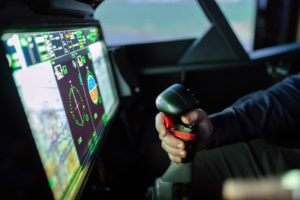
When we first start thinking about getting our pilot’s license, few of us dream about sitting in a fluorescent-lit classroom determining out what a cold front looks like. But no matter how hands-on your flight training is you will eventually have to hit the books and that’s where ground school comes into play. So, what is ground school?
Private pilot ground school is a series of courses and lectures designed to give the student the aeronautical knowledge to safely fly an airplane. Learning about flying while still on the ground has been a vital component of flight training ever since the Wright Brothers opened the first flight school in 1910. While the Wrights may have merely covered construction and flight inputs during their early ground school, today’s private pilot ground school covers a vast array of topics. Everything from weather to airframes and mechanics. This article breaks down some of the most common questions about ground school. Let’s hit the books!
What Topics are in Private Pilot Ground Schools?
The FAA lists thirteen specific areas ground training must cover for Part 141 schools. These topic areas are usually covered for Part 61 training as well. While legally ground instruction is only required to cover those thirteen specific areas, in practice, ground school often covers much more. In short, the most covered ground training areas are:
- Navigation
- Radio communications
- Flight planning
- Weather systems and avoidance
- Aeronautical decision making
- Basic knowledge of aerodynamics, aircraft systems, and powerplants
In reality, this looks like using workbooks, charts, online courses, training aids, and your instructor to grasp a better understanding of the “academic” side of flying. The goal of ground school is to assist the in-flight portion of your overall flight training and to help you pass the required 60-question FAA Knowledge Test. Additionally, before going up on your first solo flight you will need to pass a pre-solo knowledge test administered by your instructor. This test includes knowledge of your specific airplane’s operational limits, airspace procedures at the airport where your solo will take place, and any other applicable rules from Parts 61 and 91 of the Federal Regulations.
Ground school can feel like a return to your high school science class. Only this time there is an end goal in sight with real-world benefits and consequences. It is meant to be taken seriously, and your instructor will have to endorse you on your ground school hours before you are allowed to take your checkride.
How Much Ground School is Required?
It depends. If you attend a Part 141 flight school, the FAA requires 35 hours of ground training. However, if you attend a Part 61 school, there is no hour requirement. All that is required is an endorsement from your instructor to take the FAA Knowledge Test. Even for a Part 61 student, it’s good to plan on 25-35 hours of ground learning to pass the Knowledge Test. While it may take 25-35 hours, how quickly you get those 25-35 hours is up to you. Some courses offer a go-at-your-own-pace type of schedule. While others are more regimented (meeting twice a week at night, for example). Some ambitious flight schools offer accelerated programs that allow you to knock out ground school in one to two weeks.
Can I do Ground School Online?
Yes! In fact, ground school has increasingly become a virtual component. Online ground instruction has consistently started to replace in-class learning. Most often a student will take an independent, online, ground school course and then have periodic review sessions with their own personal instructor to cover any questions. This is perhaps the most effective and widely used method of accomplishing ground training.|
Our online ground school is extremely beneficial to students because we offer videos per every subject area that you can watch and re-watch at your own pace. Programs like Angle of Attack’s Private Pilot Online Ground School are compatible with any device that has internet access (iPad, iPhone, PC, etc.). Additionally, our Angle of Attack ground school has practice review questions modeled after the FAA Knowledge Test to help check your understanding. The ground school even allows you to get endorsed to take the Knowledge Test through our program alone. This means you can knock out all your ground school hours and pass the Knowledge Test before taking a discovery flight.
What does Ground School Cost?
Ground school is a significant portion of flight training and because of its importance, it can run upwards of $300-$500 depending on your program. Additionally, you should double-check with your flight instructor for their specific one-on-one ground instruction rate. Most ground instruction sessions with your instructor are cheaper than a normal flight lesson. It is important to account for such differences in training in your billing. To prevent overpaying for ground instruction, you should consider only scheduling ground instruction with your CFI when you have questions not answered in your online program or if the instructor says it is critical to cover something on the ground.
Tips for Ground School
Don’t Bet on Bad Weather
Sometimes instructors and students “bet” on bad weather to fit in ground instruction. For example, you have planned a two-hour lesson on Friday morning, but just as you pull up to the airport mother nature has dropped the ceilings to 50 feet AGL. Often an instructor will suggest doing a one-hour ground school session instead.
This is certainly a practical option but be careful. You will not get enough bad weather hours to get the ground instruction needed to pass the Knowledge Test. Ground instruction from your CFI often will not add up to more than five hours. You have to plan for ground school on your own and don’t assume that your instructor is planning for you. Much like you, they enjoy being in the air more than being in front of the whiteboard.
Memorizing means mistakes
This is a hot-button issue in flight training circles. The FAA Knowledge Test has only so many questions in their question bank they can choose from that end up making it on your 60-question test (around 200 total questions). A trend has developed in some ground schools that instead of actually learning an area that gives a student trouble. Students simply memorize the 40 or so questions and answers in that particular study area for the student to regurgitate on test day. This may help you get above the 70% needed to pass the Knowledge Test, but cutting corners is not a habit anyone needs to develop in aviation. It certainly shouldn’t start in ground school.
Work smarter, not harder; but don’t go so far as to skimp on important opportunities to learn. Remember that even after you pass your checkride, a pilot’s license is a “license to learn.” Commander Gene Cernan, the last man to walk on the moon, many years after his moonwalk famously said “after 50 years of flying I’m still learning every time I fly.”
Can I use a Simulator for Ground Instruction?
Simulators are becoming more and more common in flight schools big and small. But how do hours in a simulator translate to ground instruction time? That question is murkier than it seems.

You likely cannot lock yourself in a simulator for 30 hours and knock out your ground instruction endorsement. In fact, FAA guidance has pointed in a direction those simulator hours actually count as flight instruction, not ground instruction. Check out this 2010 interpretation preventing ground-only instructors from logging simulator instruction time.
Whatever the case may be, hopping in a simulator is a great way to reinforce your ground school training and prepare you for possible in-flight scenarios. Do not count on it alone as a sole method for obtaining ground instruction.
Ground school looks a lot different today than it did even five years ago. Online ground school has exploded and become the new standard in aviation. There are many different ways to satisfy your ground school endorsement. Often it is a personal weighing of time, money, and learning style. If you have specific questions about ground school, feel free to reach out to any one of us at Angle of Attack and we’d be happy to help!

Michael Brown grew up flying on the banks of the Tennessee River in Chattanooga, TN. He obtained his private pilot’s license in high school and has instrument and seaplane ratings. Michael graduated from Texas Christian University, where he founded the school’s flying club, with a double major in Business and Communications. He is currently a law student at Tulane University, studying transportation law. Michael was named the Richard Collins Young Writing Award winner and has had his legal writing recognized by the American Bar Association’s Air & Space Subcommittee. When he is not flying or studying, Michael enjoys riding his bike and cheering on his Atlanta Braves.

Stay Connected
Be the very first to get notified when we publish new flying videos, free lessons, and special offers on our courses.





